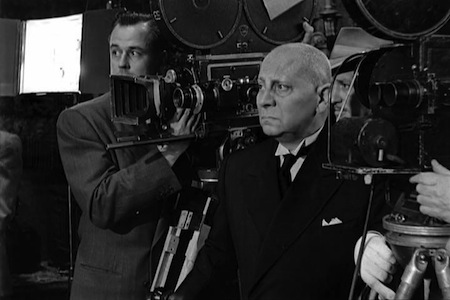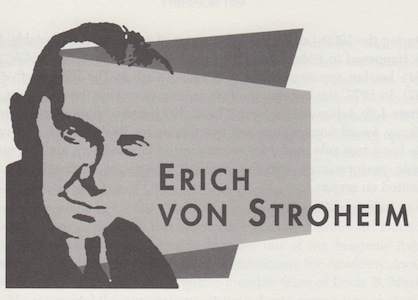Born: September 22, 1885, Vienna, Austria
Died: May 12, 1957, Maurepas, France
Hollywood killed me.
—Erich von Stroheim
The love/hate relationship between Erich von Stroheim and filmmaking touched every level of the industry. Audiences marveled at his immeasurable talent, both as an actor and director. They rushed to see the ultrarealistic settings he created and cowered in the face of his convincing portrayals of frighteningly cruel characters. Studio heads raved over his repeated commercial successes but cursed his indulgent production expenses. Fellow performers thrilled at a chance to work with him, then quit when subjected to his arrogant ways.
The Film 100
1. W.K. Laurie Dickson
2 Edwin S. Porter
3. Charlie Chaplin
4. Mary Pickford
5. Orson Welles
6. Alfred Hitchcock
7. Walt Disney
8. D.W. Griffith
9. Will Hays
10 Thomas Edison
11. John Wayne
12. J.R. Bray
13. Billy Bitzer
14. Jesse Lasky
15. George Eastman
16. Sergei Eisenstein
17. André Bazin
18. Irving Thalberg
19. Thomas Ince
20. Marlon Brando
21. Louis B. Mayer
22. Greta Garbo
23. Robert Flaherty
24. Lon Chaney
25. Anita Loos
26. George Méliès
27. Adolph Zukor
28. John Gilbert
29. Max Fleischer
30. John Ford
31. William Fox
32. George Lucas
33. Linwood Gale Dunn
34. Eadweard Muybridge
35. Katharine Hepburn
36. Winsor McCay
37. Stanley Kubrick
38. Buster Keaton
39. James Agee
40. Fritz Lang
41. Marcus Loew
42. Cedric Gibbons
43. James Cagney
44. Ben Hecht
45. Ingmar Bergman
46. Humphrey Bogart
47. Leon Schlesinger
48. Louella Parsons
49. Roger Corman
50. Edith Head
51. Bernard Herrmann
52. Gary Cooper
53. Mike Todd
54. Ernst Lubitsch
55. Sidney Poitier
56. Saul Bass
57. Billy Wilder
58. Bette Davis
59. Erich von Stroheim
60. Max Factor
61. Auguste and Louis Lumière
62. Woody Allen
63. Clark Gable
64. David O. Selznick
65. Gregg Toland
66. Lillian Gish
67. William Cameron Menzies
68. Lucille Ball
69. Samuel Rothafel
70. Akira Kurosawa
71. Marilyn Monroe
72. Vittorio De Sica
73. Natalie Kalmus
74. Gene Siskel and Roger Ebert
75. Willis O’Brien
76. Shirley Temple
77. Yakima Canutt
78. Sam Peckinpah
79. Jackie Coogan
80. Federico Fellini
81. Leni Riefenstahl
82. Steven Spielberg
83. Sam Warner
84. Jean-Luc Godard
85. Robert De Niro
86. Fred Astaire
87. Francis Ford Coppola
88. Ted Turner
89. Clint Eastwood
90. Dalton Trumbo
91. Dennis Hopper
92. Richard Hollingshead
93. Melvin Van Peebles
94. John Chambers
95. Mack Sennett
96. Martin Scorsese
97. Karl Struss
98. Busby Berkeley
99. John Hubley
100. John Cassavetes
The strangest figure in movie history, Stroheim adopted the “von” before leaving a European military academy in 1914 for America. Stints as a newspaperman, vaudeville trouper and playwright led him to Hollywood, where he informed D.W. Griffith, Allan Dwan and other directors of his uniformed past and signed on as a costume consultant for such battle epics as The Birth of a Nation (1915) and Panthea (1917).
Wanting his own directing assignment, he hustled deals for his first three films—Blind Husbands (1918), The Devil’s Passkey (1919) and Foolish Wives (1922), a trilogy of sexual fantasies that kept Hollywood gossip mills busy with rumors of debauchery on the set. Stroheim would round up enough actors and crew members to film an orgy scene, then lock them all in a warehouse together over a weekend to capture candid moments he felt would enhance the believability of the material. What went on behind those closed doors made Stroheim a worldwide curiosity.
His first great gift to the art of film was detail. Whereas many early silent films tended to use any prop or painted stage flat that happened to be lying around, Stroheim’s lavish sets were immaculate, featuring ornate furniture, authentic costumes and carefully crafted accessories. Audiences viewing a simple dinner party scene in one of his films were stunned by the beveled windows, patterned carpets, hand-carved chairs, lace tablecloths, painted dishes, polished silverware and a complete meal, always prepared correctly, accompanied by condiments and served with the proper utensils. Each detail was supervised by Stroheim, who wanted audiences to inspect every frame. This emphasis on realism would precede other directors’ by more than twenty years and strongly influence the cinema verité school of directors.
Unfortunately, Foolish Wives also earned him another sort of reputation; its lengthy running time and overbudget costs annoyed studio executives. Stroheim had been allowed his indulgences while he continued to bring in profits, but when Universal production chief Irving Thalberg was placed in charge of Stroheim’s production, the two men began a long and difficult battle of wills. When Thalberg argued over questionable expenses, Stroheim quickly whipped himself into a frenzy of delicious insults and playful hand gestures. Thalberg then issued warnings, which Stroheim flatly ignored. When weeks passed and the budget overages continued, Thalberg closed the production and cut two-thirds of the finished footage out of the film. Foolish Wives still did brisk business and added to the legend of Stroheim, with its images of women smoking cigars and other shameful practices of the day, but the feud between Thalberg and Stroheim escalated. Their differences helped to perpetuate the idea of directors as “difficult”—a term that surfaced years later with Orson Welles, Sam Peckinpah and Francis Ford Coppola, although the outlandish exploits of these successors to Stroheim paled in comparison to his own. The stigma would cast a dark shadow over the rest of Stroheim’s career.
He proved unmanageable again on Merry-Go-Round (1922), purchasing hand-embroidered silk underwear for all the extras to wear, even though the garments would never appear on film. Thalberg fumed, but Stroheim insisted the underwear was necessary to create a sense of realism in their portrayals. Thalberg had little choice but to replace the headstrong director.
When the two men were later reunited at MGM, Thalberg decided to go ahead with another one of Stroheim’s grand spectacles. The tragic novel McTeague was the source for ninety-one hours of footage, shot without aid of a formal script. The final film would become the mythic Greed (1924), considered by all who saw it the most awe-inspiring piece of entertainment ever captured on celluloid. But as production got underway and costs mounted, Thalberg was at Stroheim’s heels again. He wanted to see a rough-cut version of the film before approving additional shooting. Stroheim showed him a print that ran ten hours. Stunned by its length, Thalberg and MGM chief executive Louis B. Mayer demanded a shorter product. A four-hour version was edited by Stroheim, but Mayer, who still considered it too long, confiscated the film and had his assistants cut it down to 140 minutes. Despite huge discontinuities, critics throughout the world heralded Stroheim as a master, a genius, and nearly every director who saw Greed would cite it as inspirational.
However, the “difficult” label persisted, and eventually it would destroy one of Hollywood’s brightest careers. With Stroheim under tight supervision, MGM chanced a light operetta, The Merry Widow (1925), then another, The Wedding March (1928); both were profitable and well received. But overall, Stroheim felt that the studio system would no longer support his inventive spirit. He became insubordinate and Thalberg finally fired him. Stroheim was MGM’s star property, and perhaps the greatest working director of the time, when he was dismissed. The famous feud between the irrepressible director and the penny-wise producer, comparable to the unstoppable force running straight into the immovable object, would serve as a lesson to directors everywhere.
He retreated from directing, traveled throughout Europe, wrote screenplays and earned a modest income by acting, most notably in Jean Renoir’s Grand Illusion (1937), returning to his familiar garb as a Prussian military officer. Stroheim briefly appeared on screen in a role of poignant self-mockery in Billy Wilder’s Sunset Boulevard (1950), then quietly retired. He died in 1957.
What is left of Stroheim are the fits, the excesses, the rumors. Remembered by many of his contemporaries as one of cinema’s greatest directors, Stroheim’s influence waned after his retirement, largely because many of his films were shelved and became lost or destroyed due to deterioration of the film stock. (Efforts to salvage the remaining negatives are underway, and several videotape releases of his films have been announced). Still, few people have seen any of his work in the last fifty years. Nevertheless, his ranking reflects his seminal contribution: bringing realism to movies. Erich von Stroheim was a director willing to document his sweeping vision at all costs, and he made the first significant steps toward showing Hollywood realism in cinematic art.
To read all the republished articles from ‘The Film 100,’ go to Reintroducing the Film 100 here on Keyframe.





